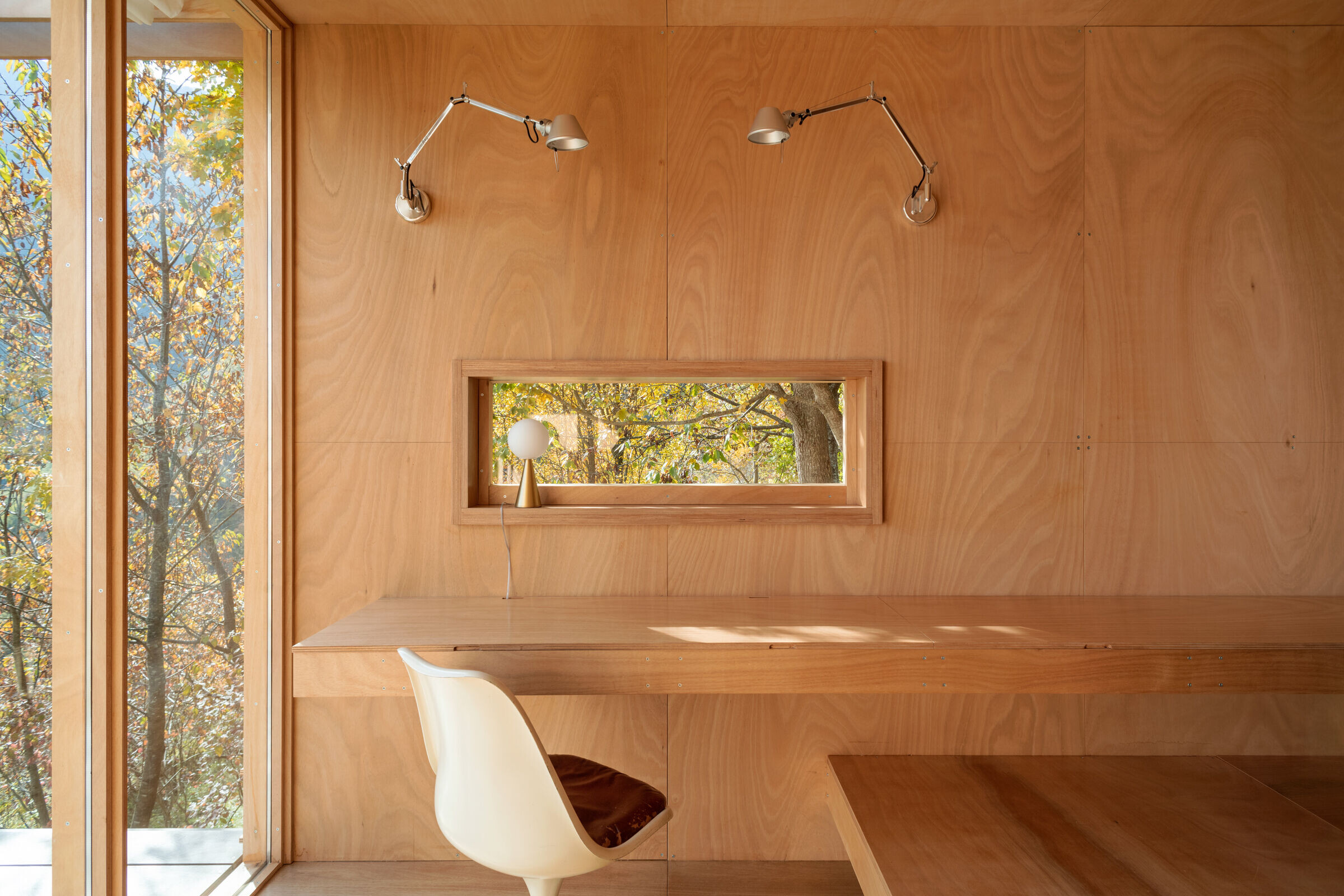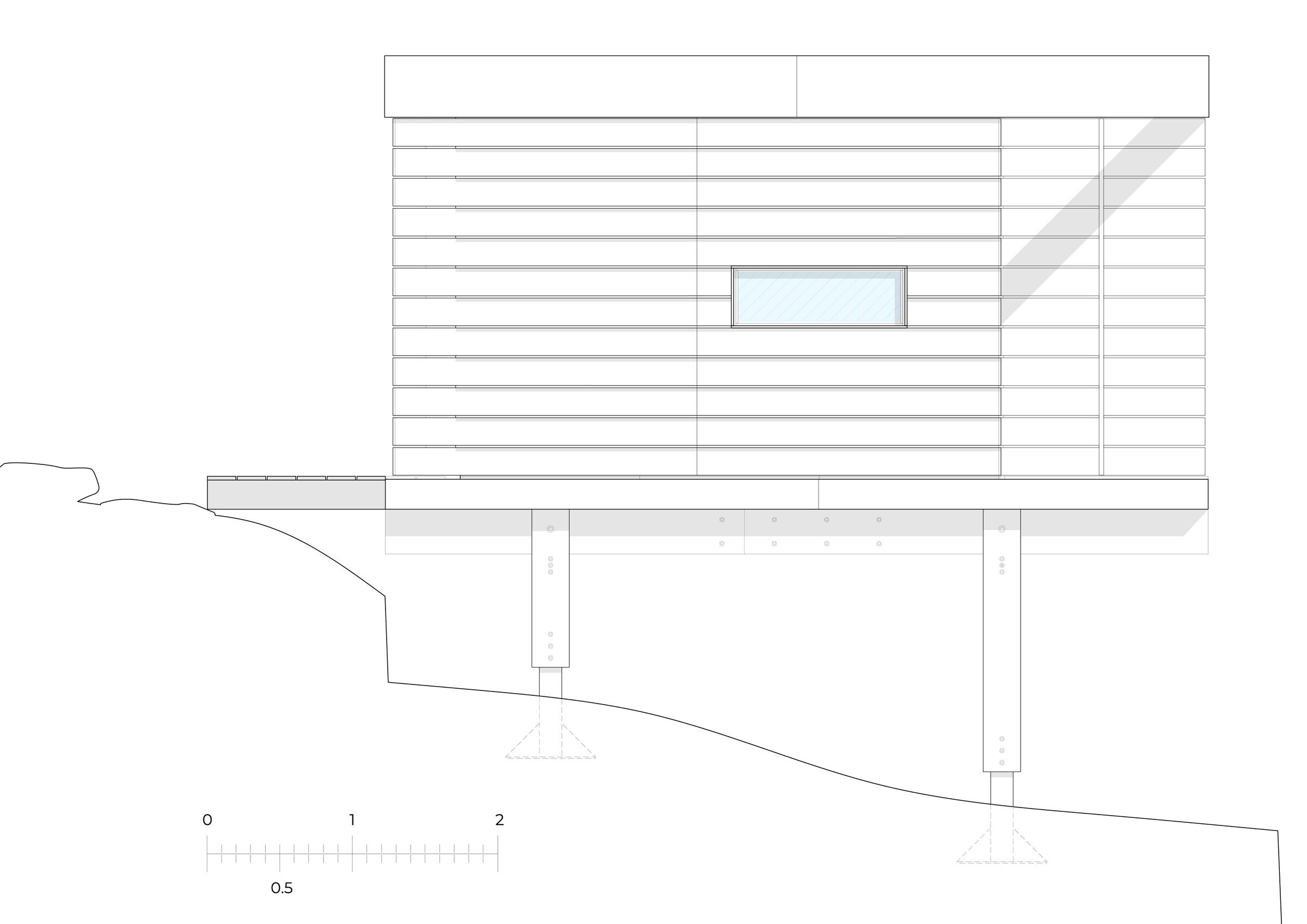The Hermitage is approached from above.
The rectangular volume, which stands off the ground is first captured in the rear part facing northwest. Here only the entrance door is visible, marked by a pronounced. The walls that define the cabin and which enclose it on three side are clad with plywood boards arranged horizontally. The fourth side facing southeast opens to the valley. Here the interior space extends into a terrace separated by four full- height glazed panels, one of which can be opened. The fenestration follows the modularity of the brise-soleil that surmounts the terrace, which in turn continues the roof structure. A small longitudinal window appears on the southwest side.

The boards of the three exterior walls are mounted to leave a gap that on either side of the entrance and on the east side of the terrace produces a filter effect. Where the walls enclose the interior space, this gap is filled with thin, slightly protruding profiles, so as to determine on the facades a play of shadows that emphasizes the horizontal pattern. At the floor level and at the top of the building tall cornices run uninterrupted, projecting from the walls and delimiting the composition.
The modularity of the structure makes it easily scalable and adaptable into different compositions. These Hermitages put human beings back in touch with nature by lightening the anthropization load that marks all building activities.


Upon entering this cabin, one is immediately offered the view of the valley below, mediated by a series of features that articulate the interior space on three different levels.


The entrance level features a countertop that runs along the entire right wall and, in guiding the visitor’s gaze outward, serves as a seat, a desk, and storage space. The third and final level, to which one descends after going through the entrance, is the one that defines the largest surface area, extended onto the terrace. The wall that encloses the tiny bathroom accommodates a fold-out bed that, when open, hovers above the sofa. The summer sun produces a variety of patterns of light and shade inside at different times of the day.


The interior space is minimal and flexible, with the expansive glass wall facing the terrace, the space feels light and contemplative.


The design of this 12 square meter Hermitage came about as an expression of the need for Luca Scardulla and Federico Robbiano, founders at llabb, to pass on to their collaborators the knowledge they had acquired in the years leading up to the opening of the studio. Their careers began in 2013 in a garage in Genoa that they converted into a carpentry workshop. There, as self- taught carpenters, learned the art of making, designing and fabricating custom furniture pieces. Over time, their handcrafted experience has characterized the architectural projects developed by the studio.

The walls, floor, and ceiling are composed of Okoumè marine plywood panels, a wood chosen for its resistance to weathering. The facades are mounted on spacer battens so as to create an air space between the facade and the walls which improves insulation performance. The roof is made of corrugated metal sheet. Above it two photovoltaic panels, connected to a storage battery, are installed. The prototype is designed to be totally off-grid, as there is a compostable toilet and water canisters. However, the structure can easily be connected to a sewer system and water supply.

Team:
Architects: llabb architettura
Other participants: Interior furniture: Via Garibaldi 12, lifestyle store
Photographers: Anna Positano, Gaia Cambiaggi, Studio Campo

Materials used:
Facade cladding: Okumè Plywood
Flooring: Okumè Plywood
Doors: Okumè Plywood
Windows: Okumè Plywood, Glass
Interior lighting: Tolomeo, Artemide. Bilia, Fontanaarte
Interior furniture: Chair: Tulip Chair, Knoll (vintage). Tea set: Olio, Royal Dulton. Paper knife: Ameland, Danese. Stool: Corck Family Model C, Vitra. Desk set: GIOBAGNARA






















































